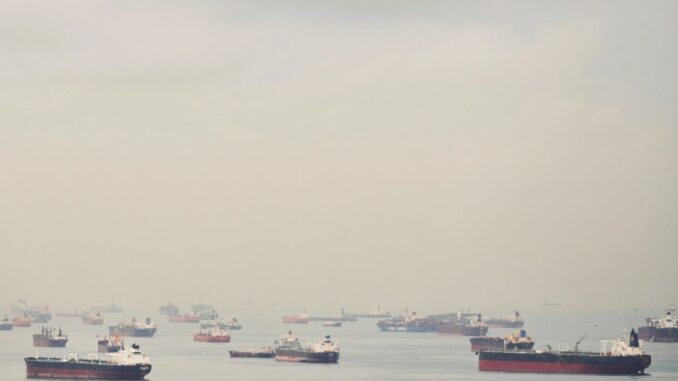
In the volatile world of energy markets, headlines from major financial institutions like Citigroup often grab attention. Recently, Citi analysts suggested that a potential de-escalation in the Russia-Ukraine conflict could drive oil prices down toward $50 per barrel, accelerating an already emerging supply surplus.
This comes amid reports of a “billion-barrel flotilla” signaling the long-awaited arrival of excess oil on global markets.
But as we dig deeper at Energy News Beat, the real story isn’t just about peace pushing prices lower—it’s about the complex interplay of lifted sanctions, post-war reindustrialization, and shifting supply-demand dynamics that could reshape pricing in unexpected ways.
The Citi Outlook: De-escalation as a Bearish TriggerCitigroup’s senior commodities strategist, Eric Lee, outlined a bear-case scenario where reduced geopolitical tensions in Ukraine could precipitate a faster drop in oil prices. With Brent crude already down about 18% this year and hovering near $61 per barrel, the key drivers here are diminished risks to Russia’s refinery network from Ukrainian attacks and eased diplomatic pressure on buyers of Russian crude.
Essentially, de-escalation would strip away the “risk premium” baked into current prices, allowing markets to fully absorb the growing surplus without the overhang of conflict-related disruptions.
This aligns with broader market sentiment. Oil prices have been sliding on expectations of oversupply, with recent data showing no progress on Ukraine peace talks keeping a floor under prices for now.
But Citi’s $50 target isn’t just speculation—it’s tied to the idea that normalized Russian oil flows could flood the market further, exacerbating the surplus. The real problem is that Russia lacks significant spare capacity.
The Surplus Reality: A Billion-Barrel Wake-Up Call
Bloomberg’s coverage paints a stark picture of the supply glut materializing at sea. Over the past year, more than 1 billion barrels of oil have accumulated on the world’s tanker fleet, the largest such buildup since the 2020 Saudi-Russia price war amid the COVID-19 demand collapse.
This “flotilla” serves as floating storage, a clear sign that production is outstripping demand, with inventories swelling globally.
Recent forecasts from the International Energy Agency (IEA) underscore this shift. In their October 2025 Oil Market Report, the IEA downgraded its 2025 global oil demand growth outlook, projecting total demand at around 103.8 million barrels per day (mbd), while supply remains robust despite potential risks from sanctions on Russia and Iran.
U.S. production continues to soar thanks to efficiency gains, even with stagnant rig counts, adding to the pressure.
Meanwhile, OPEC’s production cuts have been offset by non-OPEC supply growth, leading to predictions of Brent averaging $62 per barrel in Q4 2025 and potentially dipping to $52 in 2026.
|
Metric
|
2024 Estimate
|
2025 Forecast
|
2026 Forecast
|
|---|---|---|---|
|
Global Oil Demand (mbd)
|
~102.5
|
103.8
|
104.5
|
|
Global Oil Supply (mbd)
|
~102.0
|
104.0+ (surplus emerging)
|
105.0+
|
|
Brent Crude Price ($/bbl)
|
$81 avg.
|
$74 avg. (EIA); $50 bear case (Citi)
|
$66 avg. (EIA); lower with de-escalation
|
|
Key Drivers
|
Geopolitical risks, demand recovery
|
Surplus buildup, sanctions impact
|
Reindustrialization demand vs. supply normalization
|
Sources: IEA Oil Market Reports (Aug-Oct 2025), EIA Short-Term Energy Outlook, Citi Analysis.
The Real Story: Beyond De-escalation—Sanctions, Supply Flood, and Reindustrialization Demand
While Citi’s scenario focuses on risk reduction leading to lower prices, the “real story” lies in what happens when sanctions on Russian oil are fully lifted in a post-war environment. Western sanctions, including the EU embargo and G7 price cap, have forced Russia to sell its crude at steep discounts—often $10-20 below global benchmarks—to buyers like India and China.
These measures have shaved billions off Russia’s export revenues, dropping from pre-war levels but still totaling $235 billion in 2024 from oil and gas alone.
Toughened enforcement in 2025, including U.S. sanctions on over 180 vessels, has compounded this, but impacts on global supply flows remain modest.
If sanctions are lifted post-de-escalation:
Supply Surge: Russia, already producing near record levels despite the war, could ramp up exports without discounts or rerouting hassles. This might add 1-2 mbd to global supply in the short term, intensifying the surplus and pushing prices down further—potentially below Citi’s $50 mark if combined with non-OPEC growth.
However, Russia’s economy has been reshaped by sanctions, with constrained tech access limiting long-term output potential.
Price Normalization vs. Flood: Lifting the price cap could allow Russia to capture full market value, reducing the “shadow fleet” risks and stabilizing flows. But this normalization might not offset the volume increase; analysts argue it could tighten pressure on Putin by targeting revenues more effectively if sanctions were enforced better pre-lift.
Demand Counterbalance from Reindustrialization: Here’s the wildcard. A post-war Ukraine (and potentially Russia) would embark on massive reindustrialization and reconstruction efforts, boosting energy demand for manufacturing, infrastructure, and rebuilding. Estimates suggest this could add 0.5-1 mbd to regional demand in 2026-2027, partially offsetting the surplus.
Combined with global economic recovery and Fed rate cuts easing financial pressures, this could prevent a total price collapse.
Reducing geopolitical risk factors into pricing means stripping out the 5-10% premium currently propping up Brent. But the net effect? A short-term dip to $50-60 seems likely, but sustained lows could be mitigated by rebuilding demand. The IEA’s tempered demand growth (680 kb/d in 2025) assumes ongoing uncertainties, but a true de-escalation flips that script toward balance.
Throw Saudi Arabia’s Budget Needs Into the Mix
The Saudi deficit on their GDP is about 2.3% estimated for this year, and the Saudi Aramco royalties range between $100 billion and $200 billion, so as the leader of the OPEC and OPEC+ cartel, they have obligations.
Aramco’s Obligations to the Crown (Saudi Government)Aramco’s payments to the government—”obligations to the crown”—include royalties (tied to production and prices), income taxes (20–50% rates on profits), and dividends (as the government owns ~81.5% directly, plus indirect stakes via the Public Investment Fund). These fund ~70–80% of the budget. For 2025:Total projected dividends: SAR 320.4 billion ($85.4 billion), down sharply from $124 billion in 2024 due to lower profits and a shift away from performance-linked payouts.
The government receives ~82% of this ($70 billion).
Royalties and taxes: Based on H1 2025 data, royalties were SAR 71.8 billion ($19.1 billion) and income taxes SAR 96.2 billion ($25.7 billion).
Extrapolating (non-linear due to price volatility), full-year estimates could reach SAR 300–400 billion ($80–$107 billion) combined, depending on average prices.
Total payments from Aramco: Likely ~$150–$180 billion for 2025 at current prices, but to “meet obligations” for a balanced budget, Aramco would need to remit an additional ~$30–$60 billion, requiring oil prices near the $96 breakeven.
Aramco’s ability to meet these depends on prices: At $70/bbl, profits and payments drop; at $96/bbl, they rise sufficiently to support budget balance. The kingdom is diversifying to reduce reliance, but oil remains dominant. Projections could shift with OPEC+ decisions or global demand.
Fiscal Breakeven Oil Price for 2025The fiscal breakeven price is the oil price at which government revenues (largely from Aramco) would equal expenditures, eliminating the deficit. Estimates vary slightly by source due to assumptions on production, non-oil revenues, and spending, but consensus points to a range of $90–$98 per barrel for Brent crude in 2025. This is higher than current market prices (Brent around $70–$75 in mid-October 2025), contributing to widening deficits.
- Bloomberg Economics estimate: $96 per barrel.
- BNP Paribas: $94 per barrel.
- economic-research.bnpparibas.com
- MacroMicro: $90.94–$98.36 per barrel.
- IMF approximation: Above $90 per barrel to balance the budget.
This breakeven has risen over time due to ambitious spending on Vision 2030 projects (e.g., infrastructure, tourism diversification), despite growing non-oil revenues. For context, Saudi Arabia’s average oil production is around 9 million barrels per day (mb/d) in 2025, constrained by OPEC+ cuts. At lower prices (e.g., $60–$65/bbl), the deficit could balloon to $56–$75 billion (5.2–7% of GDP), far above planned levels.
Bottom Line for Energy Markets
The Citi warning and surplus flotilla are wake-up calls, but the real narrative is nuanced: Lifting sanctions post-war could unleash more Russian supply, hammering prices initially, yet reindustrialization demand might provide a floor. At Energy News Beat, we see this as a pivot point—oversupply dominates 2025 forecasts, but don’t count out demand surprises from peace dividends. Traders should watch IEA updates and geopolitical talks closely; the $50 floor might hold, but only if rebuilding ramps up fast.
Saudi Arabia is facing more than just budget issues. As the leader in OPEC and OPEC+, they need to have higher oil prices to meet the Saudi Aramco obligations to the crown. So, they are facing more than just overseeing the members who produce more oil when they need money for their governments, rather than printing money like the United States Federal Reserve.
Stay tuned for more breakdowns on energynewsbeat.co, and The Energy News Beat Substack, where we cut through the noise to the core market drivers. There is a resurgence to reindustrialize, and I, for one, believe that this is the beginning of new trading blocs, and good things are starting to shape up. There is no mistake about the return to commodities in the investment world, and the migration away from the Gold standard in 1971, which included gold and silver, was the single biggest mistake the US has ever made. It allowed the deep state to print money and fuel countless projects that were not in the best interest of the United States citizens.
Got Questions on investing in oil and gas? Or do you have a Tax Burden in 2025?
Crude Oil, LNG, Jet Fuel price quote
ENB Top News
ENB
Energy Dashboard
ENB Podcast
ENB Substack






